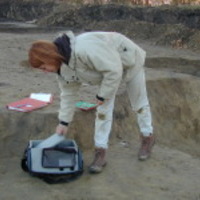
Gaia Fenoglio
Università degli Studi di Torino, Dipartimento di Chimica, PhD student in Chemical and Materials Science
Related Authors
Ellery Frahm
Yale University
Irena Lazar
University of Primorska
David Seamon
Kansas State University
Hilary Becker
Binghamton University
Hugo Gomes
Instituto Politécnico de Tomar
Mathias Mehofer
University of Vienna
Ramiro Barberena
National Scientific and Technical Research Council
Zsuzsanna Siklósi
Eötvös Loránd University
Viktória Kiss
Hungarian Academy of Sciences
Gary Feinman
Field Museum
InterestsView All (28)










Uploads
Papers by Gaia Fenoglio
During this restoration process a non invasive analytical study was realized using portable X-ray Fluorescence spectrometry and Raman spectroscopy. All the materials composing the different masks were measured, starting from the papyri and going on to the plaster used as glue; crossing to the colored parts that draw the so nice face image. A statistical base of the obtained results was supported by the comparison with similar materials, as ink, pigments, papyri and raw plasters.
In particular, analysis of both red and black inks and colors (red, yellow, blue and green) on different supports were performed. All the objects are ranged in a chronological window between the XI-XII and the XXIII dynasty that can be used to better define the manufacturing context of the production.
Analyzing the results a complete characterization of the painted layers and inks were succeeded; observing the presence of Egyptian blue, pararealgar, madder lake and red ochre, despite of the limitation of portable instrumentations [4,5]. We also report an interesting occurrence of titanium elements in some inks.
The research activity was realized in collaboration with the Società Cooperativa Archeologica (SCA), which is contributing to the scientific and conservative process act to the valorization of the Assiut archeological finds.
Talks by Gaia Fenoglio
The aim of this research is to obtain information on manufacturing techniques and composition of the artefacts, considering possible analogies and difference which may be useful for art historians discussion on manufacture place and artistic connections. XRF analysis was performed with p-XRF in order to determine the composition of the metals and enamels, and quantitative results, obtained using certified standards, undergo data treatment with multivariate analysis. Relationship between composition and material manufacturing was clearly observed, all filigrees showing higher Cu and Ag values respect to sheets and plates. In particular, the Evangelists in Pace di Chiavenna shows the highest Au content among the golden sheets, while we underline the higher Ag contents of the central filigree round respect to the external ones, suggesting for this artefact two separate manufacturing of the filigree rounds. Analysis on Pace di Ariberto differentiated originals parts from substitutions, presenting lower Au contents, and recognized as niello the black decoration on the Christ figure. The Liber Evangeliorum cover shows a wider range of compositions for Cu-Au-Ag alloys. The silver sheets of the bottom are in fact brightly reddish because of higher Cu contents, while the golden plates show high Au contents: the resulting different and contrasting colours are used to obtain a peculiar chromatic effect.
During this restoration process a non invasive analytical study was realized using portable X-ray Fluorescence spectrometry and Raman spectroscopy. All the materials composing the different masks were measured, starting from the papyri and going on to the plaster used as glue; crossing to the colored parts that draw the so nice face image. A statistical base of the obtained results was supported by the comparison with similar materials, as ink, pigments, papyri and raw plasters.
In particular, analysis of both red and black inks and colors (red, yellow, blue and green) on different supports were performed. All the objects are ranged in a chronological window between the XI-XII and the XXIII dynasty that can be used to better define the manufacturing context of the production.
Analyzing the results a complete characterization of the painted layers and inks were succeeded; observing the presence of Egyptian blue, pararealgar, madder lake and red ochre, despite of the limitation of portable instrumentations [4,5]. We also report an interesting occurrence of titanium elements in some inks.
The research activity was realized in collaboration with the Società Cooperativa Archeologica (SCA), which is contributing to the scientific and conservative process act to the valorization of the Assiut archeological finds.
The aim of this research is to obtain information on manufacturing techniques and composition of the artefacts, considering possible analogies and difference which may be useful for art historians discussion on manufacture place and artistic connections. XRF analysis was performed with p-XRF in order to determine the composition of the metals and enamels, and quantitative results, obtained using certified standards, undergo data treatment with multivariate analysis. Relationship between composition and material manufacturing was clearly observed, all filigrees showing higher Cu and Ag values respect to sheets and plates. In particular, the Evangelists in Pace di Chiavenna shows the highest Au content among the golden sheets, while we underline the higher Ag contents of the central filigree round respect to the external ones, suggesting for this artefact two separate manufacturing of the filigree rounds. Analysis on Pace di Ariberto differentiated originals parts from substitutions, presenting lower Au contents, and recognized as niello the black decoration on the Christ figure. The Liber Evangeliorum cover shows a wider range of compositions for Cu-Au-Ag alloys. The silver sheets of the bottom are in fact brightly reddish because of higher Cu contents, while the golden plates show high Au contents: the resulting different and contrasting colours are used to obtain a peculiar chromatic effect.